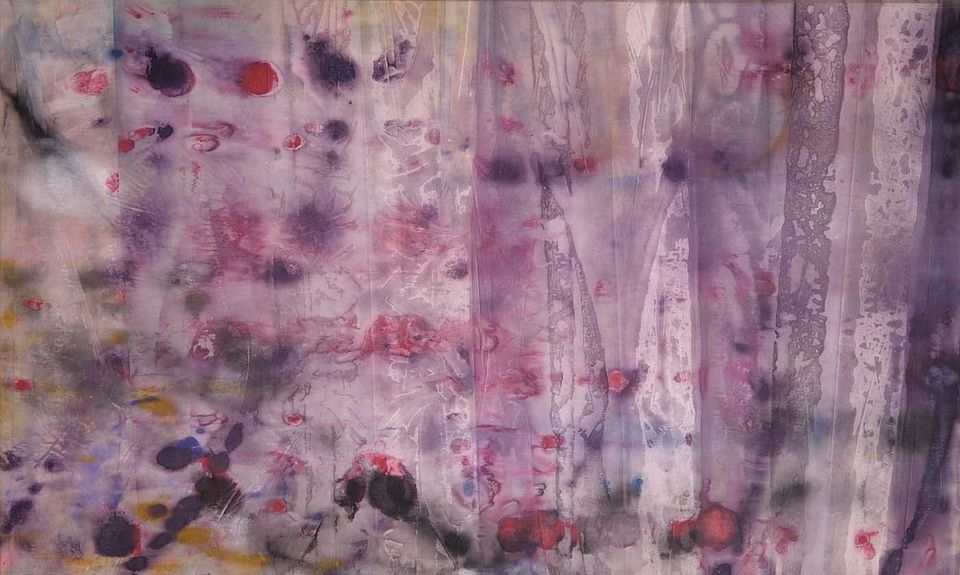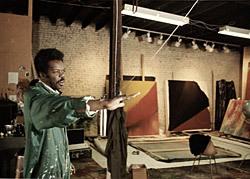
Sam Gilliam (b. 1933), April 4, 1969, acrylic on canvas, 110 x 179 3/4 in., Smithsonian American Art Museum, Museum purchase, 1973.115
Student Questions
1. What do you see when you look at Gilliam’s April 4? Be sure to describe the painting based on what you see, not what you know.
2. How can you tell that Gilliam wet the canvas before he applied the paint?
3. The artist titled this work April 4. Can you guess why?
About This Artwork
In the late 1960s, Sam Gilliam began experimenting with painting techniques new to him. He diluted acrylic paints and applied the watery colors to untreated and unstretched canvases in increasingly darker washes. As the paints soaked into the large swathes of fabric, he folded them up like accordions, added additional washes of color, and left the sopping bundles to dry. When Gilliam peeled open the canvases, he exposed dazzling abstractions made up of colorful and layered marks that echo across their surfaces. To complete the paintings, he mounted the canvases on beveled stretchers, which make them stand out slightly from the wall. April 4 is one of several paintings Gilliam made using this process.
Like the artists who first experimented with staining techniques in the early 1950s, Gilliam asserted minimal control over his work, allowing the paints to soak through the pliant canvas and form diffuse stains. These unexpected abstractions appealed to Gilliam because they offered complex visual experiences without representing anything or anyone in particular. However, by titling this work April 4—the day in 1968 that Martin Luther King Jr. was assassinated—Gilliam meant to connect it to a specific moment in history. As an artist living in Washington, D.C., and as an African American, Gilliam was deeply affected by King's assassination. In many U.S. cities, including Washington, D.C., riots broke out when news of King's death spread. From his studio window, Gilliam witnessed the looting and fires that decimated his neighborhood. A year later, when Gilliam made April 4, much of the damage had been left unrepaired, driving the inner-city neighborhood into further economic decline.
April 4 is a eulogy that evokes the grief surrounding King's tragic death and buoys us with his legacy of hope. The immense canvas of nine by fifteen feet (about the size of a one-car garage door) fills our range of vision and can seem beautiful, poignant, and overwhelming. This effect resonates with the complex emotions mourners felt on that day. On one hand, the rich stains bleed together to suggest the violence of the assassination, the trauma that followed, and the lingering feelings of bewilderment and grief. At the same time, April 4's lush, immersive veils of lavender, pink, and yellow, which seem to billow across the painting, stir the sense of hope that King and his work inspired, the glimmering sense of a new day dawning.
About This Artist
Sam Gilliam (born Tupelo, MS 1933)
Sam Gilliam is a color field painter who became internationally famous in the 1960s for draping his innovative and colorful canvases across walls and suspending them from ceilings without rigid supports and frames. He is among the relatively small number of African American artists who have chosen to paint works with no recognizable subjects despite pressure from influential African Americans to paint works that represent their shared experience. Gilliam has made clear that he will not give up his commitment to abstraction to meet other people’s expectations or desires. Raised and educated primarily in Kentucky, he received his bachelor’s and master’s degrees from the University of Louisville. He then moved to Washington, D.C., in 1962, where he taught art at a local high school. In the 1960s, Gilliam became associated with the Washington Color School, an artists’ group whose members were known for their nonrepresentational, simplified works in clear bright colors. During this period, Gilliam created his draped works. Since that time, he has worked with a variety of techniques and media, often producing works that defy categorization as painting or sculpture.
Related Material

Sam Gilliam, Swing, 1969. Acrylic and aluminum on canvas, 119 5/8 x 283 1/2 in. Smithsonian American Art Museum, Gift of Mr. Edwin Janss Jr., 1973.189
Although April 4 makes direct reference to Martin Luther King Jr., Sam Gilliam has resisted expectations that his work should reflect black identity. Around the same time he made April 4, Gilliam created Swing. Like April 4, he began with a large sheet of canvas covered in wet paint, which he then suspended from the wall, allowing it to sag and billow as it dried. The resulting work encapsulates the free form sensations of jazz music, which Gilliam often listens to in his studio. Nevertheless, Gilliam claims he intends no specific, racial meaning. Abstraction, he insists, conveys a power far greater than any political theme.

Daniel Pressley, The Soprano at the Mourning Easter Wake of 1968, 1968. Varnished walnut relief, 35 1/4 x 18 x 1 in. Smithsonian American Art Museum, Gift of Chuck and Jan Rosenak and museum purchase through the Luisita L. and Franz H. Denghausen Endowment, 1997.124.78
The assassination evoked a sense of tragic loss among the African American community, but it also fostered a resolve to continue the civil rights crusade. Daniel Pressley’s sculpture evokes the anguish many felt following Martin Luther King Jr.’s assassination. It depicts a distraught singer overcome with grief during King’s wake. Although most of the sculpture is carved in low relief, Pressley deepened his cuts around the singer’s mouth, accentuating her singing, at once a dutiful requiem and a poignant cry.
















